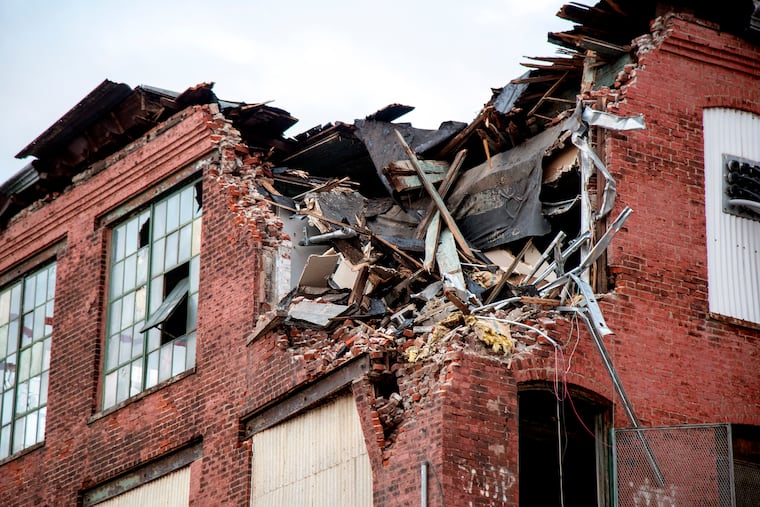Welcome to Demodelphia, where our historic buildings are treated like a burden | Opinion
Philadelphia urgently needs to enact a demolition review policy, before our unique, historic city becomes unrecognizable.

If it feels as if we live in Demodelphia, we do.
Last week I watched as a 200-year-old building at Seventh and South Streets, once home to a string of entrepreneurial immigrants, was taken down by hand. The owners of the old Reading Railroad station near Ninth and Spring Garden Streets started demolishing it last week, dashing hopes for reuse as part of the neighborhood’s revival. This week, a former hosiery mill in Olde Richmond is being wrecked by a crew so reckless it broke the street’s power lines with debris. These buildings, in whole or in part, could have been repurposed. They all held pieces of the city’s past but lacked historical protections.
Philadelphia’s history isn’t a burden, it’s our calling card. But increasing numbers of old buildings are demolished annually by city contractors and private owners, landfilling reusable materials and untold histories.
» READ MORE: Philadelphia has one of America’s richest histories. Why aren’t we doing more to protect it? | Opinion
More than two-thirds of Philadelphia buildings were built more than 50 years ago, making them potentially eligible for local historic designation on the basis of age alone. Yet less than 3% of Philadelphia’s buildings are actually designated historic, and that sliver unfortunately reflects a predominantly white version of the city’s past.
The city’s Department of Planning and Development is attempting to correct this failure through a grant-funded pilot project to develop and test a survey identifying culturally significant places overlooked by traditional preservation. The Philadelphia Tribune reported that the survey effort will be driven by the communities whose histories the historic register has excluded, particularly Black Philadelphia. The end goal is to give the department’s Historical Commission a plan to take this participatory survey method citywide, to canvass with communities for cultural landmarks and perhaps create new forms of protection for these places.
Done right, it’s all going to take years. The process could help build public trust in the city’s preservation system as it becomes less exclusionary and more representative of Philadelphia’s diverse heritage. But it does nothing to keep that history standing in the meantime.
Philadelphia urgently needs to enact a demolition review policy, at least until a citywide survey is completed.
Without demolition review, the city is undercutting its well-intentioned survey before it starts. It can’t have Historical Commission staff extend a hand to communities promising to protect sites they value, while the other issues demolition permits for the same places. At best it sends a mixed message; at worst it renders the survey’s promise hollow.
“It’s far faster to get a demolition permit than it is to designate a building as historic, which can take months.”
Cities like Chicago, Phoenix, St. Louis, and Boston all have different demolition reviews, tailored to meet local needs. They share a short time frame for permit review, such as 45 days, that applies to buildings in areas prioritized for preservation or those that meet basic eligibility for local designation, like being more than 50 years old. Applying for a permit to demolish buildings that meet these criteria triggers a review of their significance by city preservation staff before a demolition permit is issued. By establishing baseline review criteria and keeping the review period tight, building owners and developers know what to expect and reuse options may be encouraged.
It’s far faster to get a demolition permit than it is to designate a building as historic, which can take months. A demolition review policy would help level the playing field, instead of keeping it easy to level the city’s unprotected heritage.
Demolition review could prove especially helpful in recognizing exactly the kinds of overlooked but culturally meaningful places the city is hoping to capture in its new surveys. It could also help relieve any pressure on the survey process to rush through the sensitive work of collaborating in good faith with communities to build a more inclusive historic register.
These surveys are an ambitious task for a Historical Commission not known for robust community engagement. Demolition review would also create more time-sensitive work for its too-small staff. The Historical Commission deserves the resources to do both well and Philadelphia deserves no less.
» READ MORE: As Philadelphia advances streetscape plan for Spring Garden, historic buildings fall to neglect
Philadelphia’s development boom brought pre-pandemic years of record-high demolition permits, exposing the Historical Commission as outmatched, reducing many worthy old buildings to rubble. For Philadelphia’s underappreciated, culturally significant sites to have a fighting chance, the city needs new tools to temper developers’ appetites for demolition. That requires more courageous leadership from the Department of Planning and Development, its Historical Commission, and Mayor Jim Kenney, who promised to protect more of the historic places that matter to Philadelphians, that remind us who we were and are.
Otherwise, Philadelphia risks becoming unrecognizable.
Ashley Hahn writes about historic preservation and public space. @ashleyjhahn